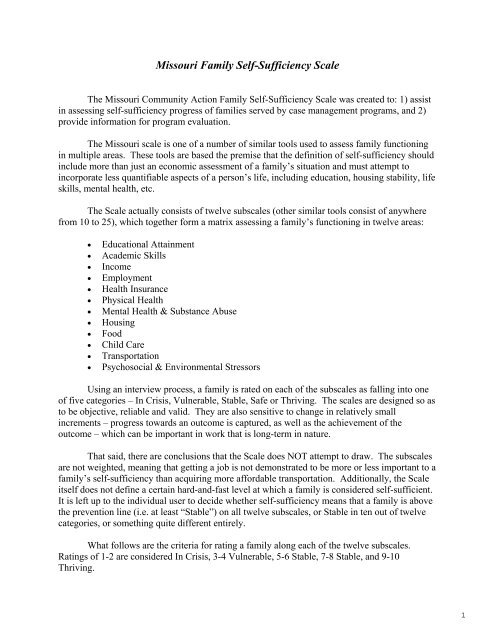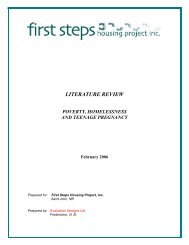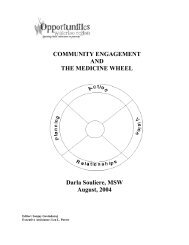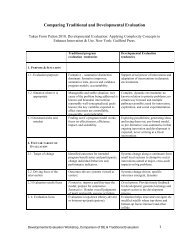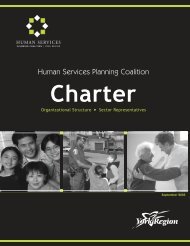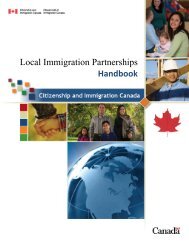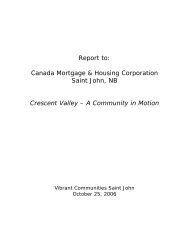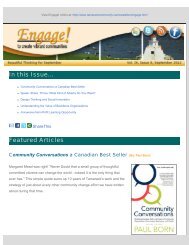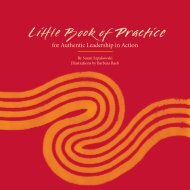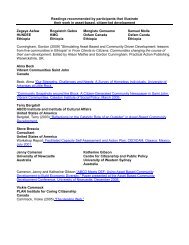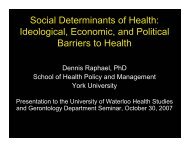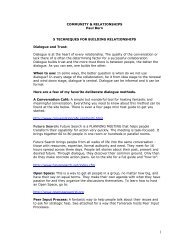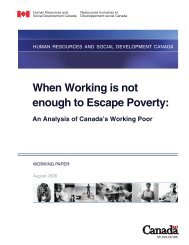Missouri Family Self-Sufficiency Scale - Tamarack
Missouri Family Self-Sufficiency Scale - Tamarack
Missouri Family Self-Sufficiency Scale - Tamarack
Create successful ePaper yourself
Turn your PDF publications into a flip-book with our unique Google optimized e-Paper software.
<strong>Missouri</strong> <strong>Family</strong> <strong>Self</strong>-<strong>Sufficiency</strong> <strong>Scale</strong><br />
The <strong>Missouri</strong> Community Action <strong>Family</strong> <strong>Self</strong>-<strong>Sufficiency</strong> <strong>Scale</strong> was created to: 1) assist<br />
in assessing self-sufficiency progress of families served by case management programs, and 2)<br />
provide information for program evaluation.<br />
The <strong>Missouri</strong> scale is one of a number of similar tools used to assess family functioning<br />
in multiple areas. These tools are based the premise that the definition of self-sufficiency should<br />
include more than just an economic assessment of a family’s situation and must attempt to<br />
incorporate less quantifiable aspects of a person’s life, including education, housing stability, life<br />
skills, mental health, etc.<br />
The <strong>Scale</strong> actually consists of twelve subscales (other similar tools consist of anywhere<br />
from 10 to 25), which together form a matrix assessing a family’s functioning in twelve areas:<br />
• Educational Attainment<br />
• Academic Skills<br />
• Income<br />
• Employment<br />
• Health Insurance<br />
• Physical Health<br />
• Mental Health & Substance Abuse<br />
• Housing<br />
• Food<br />
• Child Care<br />
• Transportation<br />
• Psychosocial & Environmental Stressors<br />
Using an interview process, a family is rated on each of the subscales as falling into one<br />
of five categories – In Crisis, Vulnerable, Stable, Safe or Thriving. The scales are designed so as<br />
to be objective, reliable and valid. They are also sensitive to change in relatively small<br />
increments – progress towards an outcome is captured, as well as the achievement of the<br />
outcome – which can be important in work that is long-term in nature.<br />
That said, there are conclusions that the <strong>Scale</strong> does NOT attempt to draw. The subscales<br />
are not weighted, meaning that getting a job is not demonstrated to be more or less important to a<br />
family’s self-sufficiency than acquiring more affordable transportation. Additionally, the <strong>Scale</strong><br />
itself does not define a certain hard-and-fast level at which a family is considered self-sufficient.<br />
It is left up to the individual user to decide whether self-sufficiency means that a family is above<br />
the prevention line (i.e. at least “Stable”) on all twelve subscales, or Stable in ten out of twelve<br />
categories, or something quite different entirely.<br />
What follows are the criteria for rating a family along each of the twelve subscales.<br />
Ratings of 1-2 are considered In Crisis, 3-4 Vulnerable, 5-6 Stable, 7-8 Stable, and 9-10<br />
Thriving.<br />
1
<strong>Missouri</strong> Community Action<br />
<strong>Family</strong> <strong>Self</strong>-<strong>Sufficiency</strong> <strong>Scale</strong><br />
Educational Attainment<br />
Rate for primary adult in program. Assign highest score possible.<br />
1. Completed 9 th grade or less.<br />
2. Completed 10 th grade - 12 th grade, non-graduate.<br />
3. Enrolled in GED program.<br />
4. Enrolled in Certificate program.<br />
5. Serving apprenticeship for trade work, e.g. sheet metal worker, carpenter, plumber.<br />
6. Completed certificate program (without GED or high school diploma), e.g., Certified Nursing<br />
Assistant (CNA) training, Cosmetology OR Employer-sponsored training institute.<br />
7. High school diploma OR GED.<br />
8. Attending or has completed some college (including continuing education courses); attending<br />
vocational training program through college or technical school.<br />
9. Completed vocational training, trades apprenticeship, or technical certificate, e.g. LPN, trade<br />
school.<br />
10. Associate degree or higher.<br />
Academic Skills<br />
Academic skills include basic reading and math skills. Rate for primary adult in program.<br />
1. Non-reader; basic math skills absent. Academic skills are a barrier to employment or goal<br />
attainment.<br />
Examples:<br />
Non-reader<br />
Unable to speak English.<br />
Unable to do simple addition/subtraction.<br />
Unable to find employment due to reading problems.<br />
2. Minimal functional academic skills present. Academic skills severely limit employment or<br />
goal attainment.<br />
Examples:<br />
Can sign name.<br />
Can read most product labels if picture represents contents.<br />
Can read most basic road signs (Stop, Yield, School, Speed Limit, Construction).<br />
Needs help completing most job applications or assignments<br />
Can perform single-digit addition and subtraction (2+9; 8-3).<br />
3. Limited functional academic skills present. Academic skills seriously limit employment or<br />
goal attainment.<br />
Examples:<br />
Can read most product labels for contents without pictures.<br />
Can use household measures, e.g., ruler, measuring cups/spoons, scale.<br />
Can read work schedule.<br />
<strong>Missouri</strong> Community Action <strong>Family</strong> <strong>Self</strong>-<strong>Sufficiency</strong> <strong>Scale</strong><br />
© <strong>Missouri</strong> Association for Community Action and Annette Backs, LCSW 3-28-99<br />
2
4. Marginal academic skills present. Academic skills considerably limit employment or goal<br />
attainment.<br />
Examples:<br />
Can read and complete simple job applications independently.<br />
Able to assist with early elementary level homework (grades 1-3)<br />
Unable to advance in job or change jobs due to reading problems.<br />
Can perform double-digit addition/subtraction (21+19=40; 87-59=28).<br />
5. Crucial academic skills present. Academic skills moderately limit employment or goal<br />
attainment.<br />
Examples:<br />
Can read young children’s books (only a few words per page, simple words and story lines).<br />
Can perform multiplication and division (2X16; 88÷4).<br />
Can accept jobs which require minimal reading or math.<br />
. (ESL) Can speak English well enough to make simple requests and responses, e.g., “Where is the ____”<br />
“Thank you” “I<br />
would like___”<br />
6. Moderate academic skills present.<br />
No problem with job applications or assignments.<br />
Can perform calculations which include fractions (½ + 3/4 = 1 1/4).<br />
Can accurately double or cut a recipe.<br />
7. Considerable academic skills present.<br />
Can read children’s chapter books.<br />
Can read newspapers and magazines.<br />
Occasionally has difficulty speaking or understanding English.<br />
Can use math for practical applications, e.g., calculating mileage, estimating.<br />
8. Substantial academic skills present.<br />
Can read some high school textbooks without difficulty.<br />
Speaks English well, has only slight problems understanding English.<br />
Can balance checkbook.<br />
9. Most academic skills present.<br />
Can read most adult-level materials without difficulty.<br />
Has only minimal difficulty speaking and understanding English.<br />
Can figure prices with percentage off.<br />
10.Academic skills are not a barrier to employment or goal attainment.<br />
<strong>Missouri</strong> Community Action <strong>Family</strong> <strong>Self</strong>-<strong>Sufficiency</strong> <strong>Scale</strong><br />
© <strong>Missouri</strong> Association for Community Action and Annette Backs, LCSW 3-28-99<br />
3
Income<br />
Note: Define income as child support, pensions, SSI, SSD, Earnings, TANF or TA, General relief, regular<br />
contributions by friends or family. Supplemental income resources include TANF or TA, SSI, General<br />
Relief, Workman’s Compensation, Unemployment benefits, Pell Educational grants, regular contributions<br />
by friends or family. Income does NOT include food stamps, Section 8, Medicaid.<br />
1. No regular or consistent income.<br />
2. Temporary income from supplemental resources. Income insufficient for basic needs for<br />
food, clothing, shelter (including utilities).<br />
3. Temporary earned income. Income insufficient for basic needs.<br />
4. Permanent earned income or Social Security Disability, but income is insufficient for basic<br />
needs.<br />
5. Temporary income from supplemental resources. Income sufficient for basic needs for food,<br />
clothing, shelter (including utilities).<br />
6. Temporary earned income. Income sufficient for basic needs.<br />
7. Permanent earned income or Social Security Disability and income meets basic needs.<br />
8. Permanent income meets basic needs and allows for some extras, e.g. birthday gifts,<br />
occasional emergencies under $100.<br />
9. Permanent income meets basic needs, allows for some extras, and emergencies over $100,<br />
e.g. car repairs.<br />
10.Permanent income meets basic needs, allows for extras, emergencies over $100, and savings.<br />
Employment<br />
If two adults are in the program, rate for the primary income provider.<br />
Part time = 29 hrs/week or less; Full time = 30 hrs/wk or more; Temporary = job expected to be<br />
available for approximately 6 months or less; Permanent = expectation that job is available<br />
indefinitely*<br />
*Include teachers and other school-year based staff in permanent employment.<br />
1. Unemployed-never worked or has not worked for 3 months or more.<br />
2. Unemployed, less than 3 months.<br />
3. Temporary part-time employment.<br />
4. Permanent part-time employment.<br />
5. Temporary full time employment.<br />
6. Full time employment- earning minimum wage or less (including tips, if applicable).<br />
7. Full time employment - above minimum wage for less than 3 months.<br />
8. Full time employment above minimum wage for 3 months or more.<br />
9. Full time employment for 3 months or more and earning living wage (Use regional amount<br />
per hour for family of 4)<br />
10.Full time employment - living wage for 6 months or more.<br />
<strong>Missouri</strong> Community Action <strong>Family</strong> <strong>Self</strong>-<strong>Sufficiency</strong> <strong>Scale</strong><br />
© <strong>Missouri</strong> Association for Community Action and Annette Backs, LCSW 3-28-99<br />
4
Health Insurance<br />
NOTE: Medicare is the health insurance available to persons eligible for Social Security retirement or disability<br />
benefits. Medicaid is the program that serves people who meet low income guidelines established by their state.<br />
Government-sponsored insurance includes Medicaid and MC+. Private insurance includes coverage through<br />
employment or school.<br />
1. No health insurance for any family member.<br />
2. All children covered by government-sponsored insurance at no cost, adults uninsured.<br />
3. All children and one adult covered by government-sponsored insurance at no cost, other<br />
adult(s) uninsured.<br />
4. All family members covered by government-sponsored insurance at no cost.<br />
5. All children and adults covered by insurance: some by no-cost government-sponsored<br />
insurance and others by private insurance (or Medicare) that is unaffordable.<br />
6. All family members covered by government-sponsored insurance, but premium(s)<br />
unaffordable.<br />
7. All family members covered by insurance: some by no-cost government-sponsored insurance,<br />
others by private insurance, government-sponsored insurance, or Medicare that has<br />
affordable premiums.<br />
8. All family members covered by private insurance or Medicare, but premium(s) unaffordable.<br />
9. All family members covered by private insurance or Medicare, premium affordable but<br />
deductable/copay unaffordable.<br />
10.All family members covered by private insurance, MC+, or Medicare, and family reportscosts<br />
of premium and deductable/copay are affordable.<br />
<strong>Missouri</strong> Community Action <strong>Family</strong> <strong>Self</strong>-<strong>Sufficiency</strong> <strong>Scale</strong><br />
© <strong>Missouri</strong> Association for Community Action and Annette Backs, LCSW 3-28-99<br />
5
Physical Health<br />
1. <strong>Family</strong> member’s health problem PROHIBITS work.<br />
Examples:<br />
<strong>Family</strong> member’s health problem does not permit education, employment.<br />
<strong>Family</strong> member has severe medical problems and cannot work.<br />
<strong>Family</strong> member has acute medical problems that need prompt attention.<br />
2. <strong>Family</strong> member’s health problem SEVERELY interferes with work.<br />
Examples:<br />
<strong>Family</strong> member’s health problem limits access to employment or education opportunities.<br />
Medication or treatment routines do not allow family member to work regular shifts/hours.<br />
3. <strong>Family</strong> member’s health problem SERIOUSLY interferes with work.<br />
Examples:<br />
<strong>Family</strong> member regularly misses work 5 or more times per month due to illness.<br />
<strong>Family</strong> member usually misses work 5 or more times per month for doctor visits or medical treatment.<br />
<strong>Family</strong> member can work only particular hours, or hours are restricted by health problem.<br />
4. <strong>Family</strong> member’s health problem CONSIDERABLY interferes with work.<br />
Examples:<br />
<strong>Family</strong> member’s work opportunities limited by health problems, e.g., no lifting, no dust, cannot work<br />
outdoors.<br />
Cannot improve employment due to health requirements.<br />
<strong>Family</strong> member regularly misses work 4 or more times per month due to illness.<br />
<strong>Family</strong> member usually misses work 4 or more times per month for doctor visits or medical treatment.<br />
5. <strong>Family</strong> member’s health problem MODERATELY interferes with work.<br />
Examples:<br />
<strong>Family</strong> member regularly misses work 3 or more times per month due to illness.<br />
<strong>Family</strong> member usually misses work 3 or more times per month for doctor visits or medical treatment.<br />
6. <strong>Family</strong> member’s health problem MILDLY interferes with work.<br />
Examples:<br />
<strong>Family</strong> member regularly misses work 2 times per month due to illness.<br />
<strong>Family</strong> member misses work 2 times per month for doctor visits or medical treatment.<br />
7. <strong>Family</strong> member’s health problem OCCASIONALLY interferes with work.<br />
Examples:<br />
<strong>Family</strong> member regularly misses work 1 time per month due to illness.<br />
<strong>Family</strong> member usually misses work 1 time per month for doctor visits or medical treatment.<br />
Some minor modifications to work environment or schedule necessary due to health problems.<br />
8. <strong>Family</strong> member’s health problem MINIMALLY interferes with work.<br />
Examples:<br />
Most appointments and/or medical treatments occur outside work hours. May use work phone to make<br />
appointments.<br />
Occasionally misses a half day or less for doctor visit or medical treatment.<br />
9. <strong>Family</strong> member’s health problem SLIGHTLY interferes with work.<br />
Examples:<br />
Health concerns usually taken care of without absence, e.g.,takes breaks to use inhaler for asthma, takes<br />
frequent breaks to avoid sitting for extended periods.<br />
10.<strong>Family</strong> members have no ongoing health problems OR health problems do not interfere with<br />
work.<br />
Examples:<br />
<strong>Family</strong> members are generally healthy.<br />
Health problems are controlled by medication or other treatment and do not contribute to absence from<br />
work.<br />
<strong>Missouri</strong> Community Action <strong>Family</strong> <strong>Self</strong>-<strong>Sufficiency</strong> <strong>Scale</strong><br />
© <strong>Missouri</strong> Association for Community Action and Annette Backs, LCSW 3-28-99<br />
6
Mental Health and Substance Abuse<br />
1. Household needs for food and/or shelter (rent/mortgage, utilities) are UNMET due to<br />
substance abuse AND/OR mental illness.<br />
Examples:<br />
Children living outside the home for more than 30 days due to substance use problems or mental illness of<br />
parent.<br />
Substances require most or all of family financial resources each month.<br />
Mental illness results in frequent hospitalization.<br />
Frequent lack of food, electricity cut off, eviction notices due to substance use or mental illness.<br />
2. Substance abuse and/or mental illness has SEVERE impact on household needs.<br />
Examples:<br />
<strong>Family</strong> member lost job or left school due to substance abuse or mental illness.<br />
Physical/mental illness due to substance abuse.<br />
Substance abuse or mental illness is barrier to employment.<br />
Rural: Unable to work due to lost drivers license.<br />
3. Substance abuse and/or mental illness has SERIOUS impact on household needs.<br />
Examples:<br />
Household member has legal problems due to substance abuse or mental illness.<br />
Paying restitution that makes paying for basic needs a problem.<br />
Mental illness creates severe financial problems, e.g., gross overspending during manic episodes.<br />
4. Substance abuse and/or mental illness has CONSIDERABLE impact on household needs.<br />
<strong>Family</strong> member considered disabled (by Social Security) due to mental illness.<br />
Medication for mental illness is unaffordable.<br />
<strong>Family</strong> member frequently requires hospitalization for mental illness.<br />
<strong>Family</strong> member frequently requires inpatient or full-time treatment for substance abuse.<br />
5. Substance abuse and/or mental illness has MODERATE impact on household needs.<br />
Examples:<br />
Drivers license lost or limited due to substance abuse or mental illness.<br />
Mental illness inhibits full time employment.<br />
<strong>Family</strong> member attends support group or treatment program three or more times per week.<br />
6. Substance abuse and/or mental illness has MILD impact on household needs.<br />
Examples:<br />
<strong>Family</strong> member regularly attends support groups or treatment program two times per week. Costs are<br />
within family’s budget capacity.<br />
Medication and/or other treatments control most symptoms of mental illness.<br />
7. Substance abuse and/or mental illness has OCCASIONAL impact on household needs.<br />
Examples:<br />
<strong>Family</strong> member occasionally requires brief hospitalization for mental illness.<br />
<strong>Family</strong> member occasionally uses household expense money for substances.<br />
8. Substance abuse and/or mental illness has MINIMAL impact on household needs.<br />
Examples:<br />
Symptoms of mental illness are mostly controlled by medication.<br />
<strong>Family</strong> member attends support group or treatment program one time per week.<br />
9. Substance abuse and/or mental illness has SLIGHT impact on household needs.<br />
Examples:<br />
Symptoms completely controlled by medication which is affordable (or covered by insurance).<br />
<strong>Family</strong> member occasionally attends support group or uses particular people for support.<br />
10.No impact on household needs due to substance abuse or mental illness.<br />
<strong>Missouri</strong> Community Action <strong>Family</strong> <strong>Self</strong>-<strong>Sufficiency</strong> <strong>Scale</strong><br />
© <strong>Missouri</strong> Association for Community Action and Annette Backs, LCSW 3-28-99<br />
7
Housing<br />
1. Homeless or severely substandard housing.<br />
Examples:<br />
Residing/sleeping in unsheltered situations, such as park bench<br />
Living out of vehicle<br />
Staying in abandoned buildings<br />
Living on the street<br />
Housing lacks running water, working plumbing/septic system, working heating system, and/or safe<br />
electrical system.<br />
2. Temporary housing.<br />
Examples:<br />
Roving house to house<br />
Temporarily staying with friends or relatives<br />
Residing in a shelter<br />
Residential treatment program<br />
3. Transitional housing<br />
Examples:<br />
Home or apartment where family can live for up to six months before getting permanent housing.<br />
Agency-sponsored temporary housing program<br />
Short term lease or other agreement for moving in less than six months<br />
4. Permanent subsidized housing, but subsidy or lease threatened due to breach of contract, e.g.<br />
delinquent/disconnected utilities, property neglect, rule violations OR permanent subsidized<br />
housing in need of major repairs. For example: roof leaks, lead paint present, nonworking<br />
plumbing, electrical, heating.<br />
5. Permanent non-subsidized housing, current threat of eviction or foreclosure.<br />
6. Permanent subsidized housing. No threat of eviction or loss of subsidy. No major repairs<br />
needed.<br />
7. Permanent unsubsidized housing, but rent/mortgage and utility costs are more than 50% of<br />
income AND home is in need of immediate major repairs. For example: roof, siding or<br />
painting needs immediate attention; furnace or plumbing is unreliable.<br />
8. Permanent unsubsidized housing, but rent/mortgage and utility costs are more than 50% of<br />
income; home does not require major repairs (see #7 for examples) immediately.<br />
9. Permanent unsubsidized housing. Rent/mortgage and utility costs (unsubsidized) are less<br />
than or equal to 50% of income.<br />
10.Permanent unsubsidized housing. Rent/mortgage and utility costs (unsubsidized) are less<br />
than 50% of income AND have been kept current for at least 3 consecutive months.<br />
<strong>Missouri</strong> Community Action <strong>Family</strong> <strong>Self</strong>-<strong>Sufficiency</strong> <strong>Scale</strong><br />
© <strong>Missouri</strong> Association for Community Action and Annette Backs, LCSW 3-28-99
Food<br />
1. <strong>Family</strong> has no food or reports that they are hungry.<br />
2. <strong>Family</strong> reports they have adequate food, but have no resources to cook and/or refrigerate food.<br />
Examples:<br />
<strong>Family</strong> can get food from pantry but is living in hotel so they cannot cook or refrigerate food.<br />
<strong>Family</strong> has food in the house, but utilities are disconnected so they cannot cook or refrigerate food.<br />
3. <strong>Family</strong> eats meals in homeless shelter OR family eats most meals with friends or relatives.<br />
4. <strong>Family</strong> uses supplementary food resources 4 or more times per month. Do NOT include use of<br />
food stamps, WIC, or free/reduced school lunch/breakfast programs in count.<br />
Supplementary food resources includes: food pantries, soup kitchens, commodity food, food stamps, WIC,<br />
free/reduced school breakfast/lunch programs, and other free or reduced fee food resources used to supplement the<br />
family.<br />
5. <strong>Family</strong> uses supplementary food resources 2 or 3 times per month. Do NOT include food stamps,<br />
WIC, or free/reduced school lunch/breakfast programs in count.<br />
6. <strong>Family</strong> uses supplementary food resources once or less per month. Do NOT include free/reduced<br />
school lunch/breakfast programs, WIC, and food stamps.<br />
7. <strong>Family</strong> uses only food stamps, WIC, and free/reduced school lunch/breakfast programs as<br />
supplementary resources.<br />
8. <strong>Family</strong> uses only free school lunch/breakfast programs or WIC as supplementary resources.<br />
9. <strong>Family</strong> uses only reduced school lunch/breakfast programs.<br />
10. <strong>Family</strong> obtains meals independent of supplemental food resources, including food stamps.<br />
Child Care<br />
1. Child care needed for education or employment is not available OR child care not currently needed<br />
due to unemployment, but will need child care when employed.<br />
Examples: Evenings, weekends, infants, special needs children.<br />
2. Child care available, but costs exceed potential income.<br />
3. Child care and subsidy are available, but child care provider will not or cannot accept subsidy.<br />
4. Child care available, subsidy accepted by provider, but copay unaffordable.<br />
5. Child care available, subsidy unavailable, but costs exceed 30% of income.<br />
6. Child care available, affordable (may use subsidy), but transportation problems are a problem.<br />
Examples: <strong>Family</strong> has no transportation to child care site.<br />
No transportation from child’s school to child care provider.<br />
Getting child to provider is too expensive or time consuming.<br />
7. Child care available, affordable (may use subsidy), but of poor quality.<br />
Poor quality examples: Potential safety hazards, unclean, unlicensed, poorly supervised, no structured activities,<br />
unreliable.<br />
8. Child care available, affordable (may use subsidy), and of medium quality OR high quality<br />
subsidized care.<br />
Medium quality examples: Reliable, no safety hazards, some structured activities, variety of toys, nutritious meals,<br />
usually supervised.<br />
9. Child care is available, affordable without subsidy, and of high quality.<br />
High quality examples: Very reliable, constant adult supervision, daily planned structured activities, ageappropriate<br />
toys, environment is clean and stimulating, no safety hazards, nutritious meals and snacks.<br />
10. Child care is available, affordable without subsidy, of high quality, AND includes at least one<br />
emergency backup care giver or plan. OR <strong>Family</strong> has no children.<br />
<strong>Missouri</strong> Community Action <strong>Family</strong> <strong>Self</strong>-<strong>Sufficiency</strong> <strong>Scale</strong><br />
© <strong>Missouri</strong> Association for Community Action and Annette Backs, LCSW 3-28-99
Transportation<br />
1. NO transportation available<br />
Examples:<br />
No money for transportation expenses (car, bus/cab fare). No public transportation.<br />
Suspended/revoked license.<br />
No friends/relatives to help with transportation.<br />
2. MINIMAL access to transportation.<br />
Examples:<br />
Have valid drivers license, but no car or access to car.<br />
Can occasionally get ride with friend/relative.<br />
3. LIMITED access to transportation.<br />
Examples:<br />
Have drivers license and can occasionally use friend/relative’s car.<br />
Have court-limited drivers license, e.g., can drive only to work.<br />
4. MARGINAL transportation available.<br />
Examples:<br />
Friend/relative routinely provides transportation to work only.<br />
Car won’t run, needs frequent repairs, and/or is unreliable.<br />
Have car, but no insurance and/or tags.<br />
5. CRUCIAL transportation available.<br />
Examples:<br />
Needed routes/hours available on public transportation available, but don’t know how to use it.<br />
Friend/relative transports to work, grocery store, medical appointments.<br />
6. MODERATE access to transportation.<br />
Examples:<br />
Public transportation available, but has limited hours or routes.<br />
Car runs, but won’t pass inspection.<br />
7. CONSIDERABLE transportation needs met.<br />
Examples:<br />
Car usually runs, but presently needs repair.<br />
Frequently has no money for gas.<br />
Public transportation fares unaffordable.<br />
Car insurance up to date, tags valid.<br />
8. SUBSTANTIAL transportation needs met.<br />
Examples:<br />
Work/school obligations require second car or transportation arrangements.<br />
Ride available for most needs, but occasionally unavailable.<br />
Occasionally without money for gas or public transportation.<br />
9. Most transportation needs met.<br />
Examples:<br />
Car useable, meets inspection, but wearing out. Major repairs expected in next few months.<br />
Public transportation fares affordable and routes/schedules serve most needs, but must use taxi for some trips.<br />
10.Transportation not a problem. Satisfactory access, reliability. All transportation needs met.<br />
<strong>Missouri</strong> Community Action <strong>Family</strong> <strong>Self</strong>-<strong>Sufficiency</strong> <strong>Scale</strong><br />
© <strong>Missouri</strong> Association for Community Action and Annette Backs, LCSW 3-28-99
Psychosocial and Environmental Stressors<br />
NOTE: The same situation may be experienced at different intensities by different families. Use the labels below as they<br />
apply to the family in consideration. Rate only stressors that interfere with the family’s ability to become/remain selfsufficient.<br />
If no such stressors are present, score as 10. Examples of stressors: Domestic violence, child abuse/neglect,<br />
legal problems, divorce, death of loved one, victim of crime, immigration, incarceration, stressful relationships, family<br />
discord, marital problems, dissatisfaction with work, parent/child problems, victim of natural disaster or fire.<br />
1. Pre-occupation with stressor to the extent that family member is UNABLE to address selfsufficiency<br />
goals.<br />
Examples:<br />
Victim of natural disaster, e.g., tornado, flood<br />
Current domestic violence<br />
2. Ability to address self-sufficiency goals is SEVERELY influenced by stressor.<br />
Examples:<br />
Frequent domestic violence.<br />
Children removed from home due to abuse or neglect.<br />
<strong>Family</strong> member incarcerated.<br />
Cohabitant prevents self-sufficiency.<br />
3. Pre-occupation with stressor SERIOUSLY impairs ability to focus on self-sufficiency goals.<br />
Examples:<br />
<strong>Family</strong> disrupted by recent divorce, separation, or estrangement<br />
Severe illness of family member<br />
4. Stressor CONSIDERABLY influences family member’s ability to focus on self-sufficiency goals.<br />
Takes substantial effort to turn energy toward goals.<br />
Examples:<br />
Recent victim of crime.<br />
Severe legal problems.<br />
Outstanding fines or heavy debt.<br />
5. Stressor MODERATELY influences family member’s ability to focus on self-sufficiency goals.<br />
Examples:<br />
Record of felony.<br />
Difficulty adjusting to a new culture.<br />
Unexpected illness lasting more than 3 weeks.<br />
6. Stressor MILDLY influences family member’s ability to focus on self-sufficiency goals.<br />
Examples:<br />
Stressful work schedule or work relationships.<br />
Difficulties with neighbors or landlord.<br />
Problems with access to health care.<br />
7. OCCASIONALLY has periods of more than 2 days when is unable to focus on goals due to stressor.<br />
Examples:<br />
Strained family relationships or marital problems.<br />
Dissatisfaction with work.<br />
8. MINIMAL problems focusing on self-sufficiency goals. Problems transient and not unexpected.<br />
Examples:<br />
Anniversary of death of loved one.<br />
Truancy of child.<br />
9. Influence on ability to focus on self-sufficiency is SLIGHT. No more than everyday problems and<br />
is able to negotiate solutions to problems as they arise. Remains focused on goals.<br />
Examples:<br />
Parent/child problems.<br />
10. No significant stressors that currently interfere with self-sufficiency.<br />
<strong>Missouri</strong> Community Action <strong>Family</strong> <strong>Self</strong>-<strong>Sufficiency</strong> <strong>Scale</strong><br />
© <strong>Missouri</strong> Association for Community Action and Annette Backs, LCSW 3-28-99


